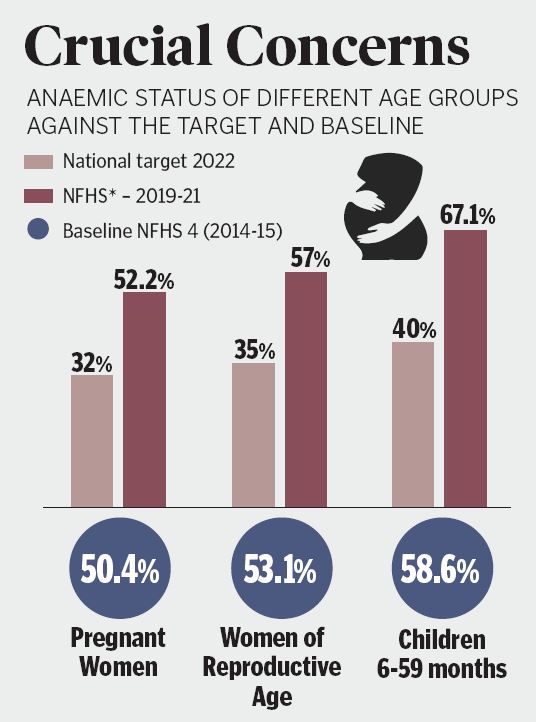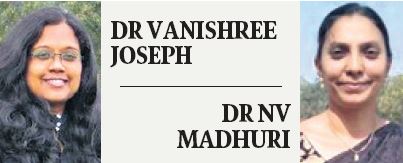Opinion: Problem of persisting anaemia
By Dr Vanishree Joseph, Dr NV Madhuri Anaemia is one of the major dietary deficiencies in India, with preschool children and teenage girls, as well as pregnant and lactating mothers, being the most vulnerable groups. The primary cause of anaemia is the inadequate intake of iron-rich food. Household size, education level and other infectious diseases […]

By Dr Vanishree Joseph, Dr NV Madhuri
Anaemia is one of the major dietary deficiencies in India, with preschool children and teenage girls, as well as pregnant and lactating mothers, being the most vulnerable groups. The primary cause of anaemia is the inadequate intake of iron-rich food. Household size, education level and other infectious diseases are also contributing factors. Prevailing gender inequality among men and women, boys and girls further add to the numbers.
India started implementing several iron and folic acid supplementation programmes since 1970 to reduce the prevalence of iron deficiency anaemia. National Nutritional Anemia Prophylaxis Programme, National Nutrition Policy and National Iron Initiative to name a few, and at present Anemia Mukt Bharat- Intensified iron plus initiative is in progress from 2018 onwards. This new programme also supports POSHAN Abhiyaan, with the aim to leave no one behind while reiterating the message of health for all.
Little Change
According to the data from the National Family Health Survey (NFHS), the prevalent anaemia decreased by only 2% from 2005 to 2015 among women of reproductive age. In 1998, it was 52% but saw a marginal increase in 2015. The target set for Anemia Mukt Bharat is to reduce the prevalence of anaemia by 3 percentage points per year among children, adolescents and women in the reproductive age group between 2018 and 2022. However, rather than getting decreased from baseline, it has increased, as per the latest NFHS-5 (2019-21) data. (See infographics) If this trend continues, achieving many of the Sustainable Development Goals (SDGs) in terms of health indicators for women and children by 2030 will not be possible. Prevalence of anaemia will have an impact on maternal mortality, stillbirth, infant mortality, undernourishment and other quality of life issues.
Narrow Focus
Six decades of continuous initiatives by the governments focused on the supply chain of distributing iron supplements and promoting diet diversification. Interventions on the demand side to influence behaviour and societal norms are rarely considered. That’s why when the supply chain was disrupted because of the Covid-19 pandemic, most women and children got affected.
The Anemia Mukt Bharat strategy to some extent focuses on behaviour change through its communication campaign. The four key behaviours include improving compliance to iron folic acid supplementation and deworming; appropriate infant and young child feeding practices; increase in intake of iron-rich food through diet diversity/quantity/frequency and/or fortified foods with a focus on harnessing locally available resources; and ensuring delayed cord clamping after delivery (by 3 minutes) in health facilities.
But social norms like women eating last and least, aversion towards consuming iron tablets for various reasons like coloured stool, believing baby will be born dark, big baby might lead to c-section delivery and so on, are not addressed. Moreover, the health-seeking behaviour of women is always dependent on their spouses and family members. Especially for socially marginalised poor women living in rural areas, access to nutritious food and health facilities is at the disposal of patriarchy and social hierarchy. This vicious cycle should be broken and made a part of policy interventions.
Women’s Autonomy
Research show that financial decision-making power within the family has a strong association with the prevalence of anaemia. Women”s autonomy in seeking treatment and purchasing nutritional foods may be limited by a lack of control over household resources. Prevailing policy interventions communicate with women and girls regarding the importance of nutritious food intake but those policies do not have a stake in determining the purchasing power of women and girls within the household.
Household is the important phenomenon that determines the parity among its members. Therefore, policy interventions should shift their focus from targeting individuals to households, which becomes essential for holistic development. The issue of gender and social norm cannot be addressed at the individual level. To start with, it can be addressed at the household level and later the result will get manifested at the societal level.
The need of the hour is the shift in the paradigm of policy intervention from individual to household. The effort can be decentralised and the role of local governing institutions can be enhanced.
Rather than implementing each and every policy as a separate entity, convergence of different policies can happen at the grassroots. For instance, synergising the work of Anganwadi workers, farmer producer organisations (FPOs) and self-help group (SHG) members might yield a good result in terms of sensitisation, dietary diversification and empowerment. Anaemia cannot be prevalent for decades and affect productivity, social capital and healthy citizens. If anaemia continues to prevail, the future of our future generations is at stake.



(Dr Vanishree Joseph is Assistant Professor and Dr NV Madhuri is Head, Centre for Gender Studies and Development, NIRDPR, Hyderabad)
Related News
-
Drone ban imposed by Cyberabad police for President’s visit
3 mins ago -
Vritti Agarwal wins 1500m freestyle gold at inter-university championship
15 mins ago -
Indian Women’s League ninth season kicks off with eight teams in action
18 mins ago -
Varsha Thirupothu wins under-15 girls event at UBS Athletics Kids Cup
21 mins ago -
Mumba Masters beat Ganges Grandmasters to go top in GCL standings
26 mins ago -
Five-day D Sons Patola Art Exhibition opens in Banjara Hills
28 mins ago -
Lakshita Bishnoi and Sharvan Kumar win gold in 10m Air Pistol Mixed Team
29 mins ago -
Abhiraj Vashisht hits 175 as Haryana dominate Hyderabad in Vijay Merchant Trophy
32 mins ago




